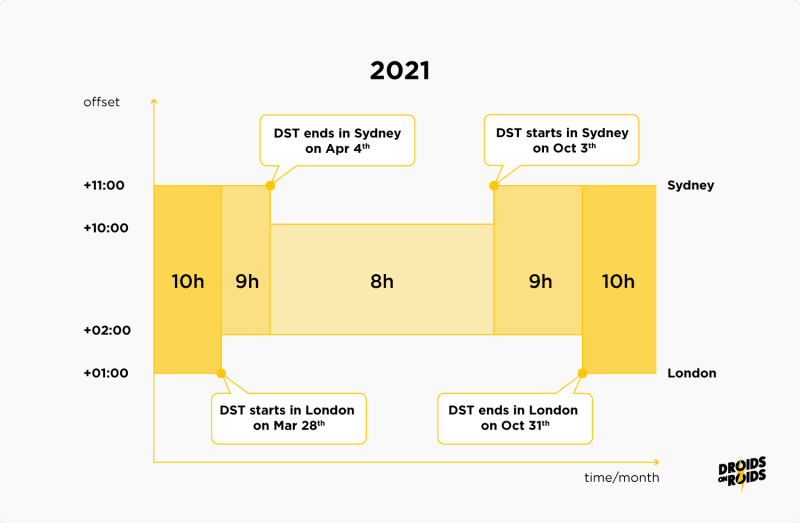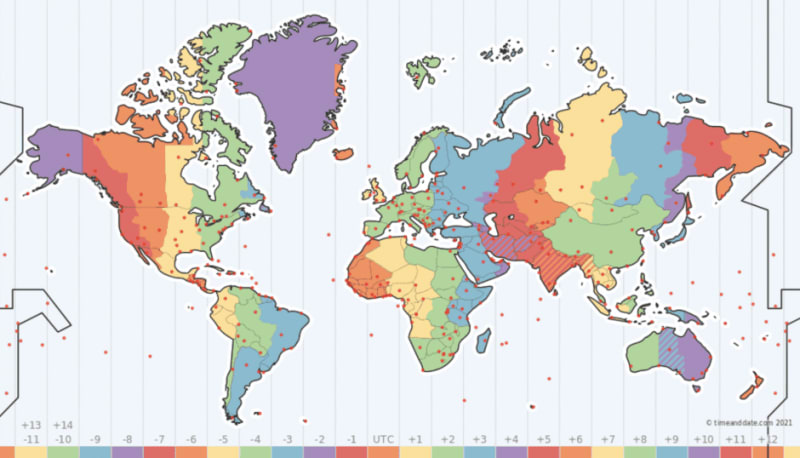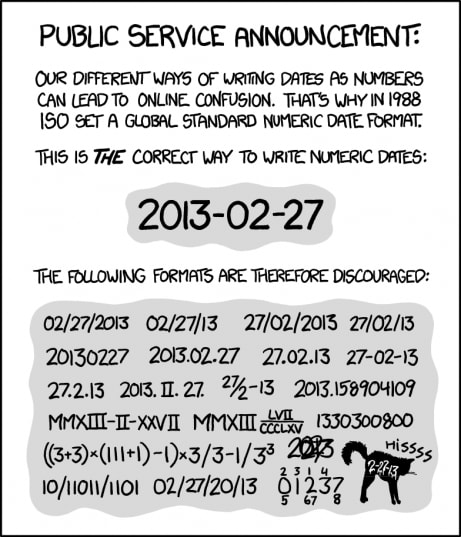應用程式和後端開發中的邊緣案例 - 日期和時間
Introduction
You may think that dealing with dates and time is easy. We have a minute that lasts 60 seconds, an hour with 60 minutes, a day with 24 hours, a week with 7 days, a month with 28 to 31 days, and so on.
Surely no rocket science is required here…
Well, nothing could be further from the truth!
We will show the traps and pitfalls related to date and time that you may encounter during application and backend development.
Measurement units
Let’s start with the units of measurement, from the smallest ones to the largest.
Seconds and milliseconds
The smallest unit used everyday is a second. It is also the base of Unix time.
However, in some programming languages, such as Java, the most common unit is a millisecond (1/1000 of the second), as by the System.currentTimeMillis() method, for example.
That divergence may lead to many errors.
If you receive the numeric value from outside your system, it might not at first glance be clear what unit of measurement it uses, even after reading the documentation!
Look at the DATE field in the SMS and MMS content provider (database) columns. Both docs say only:
The date the message was received.
Type: INTEGER (long)
However, the SMS uses milliseconds while the MMS uses seconds. Surprised? Well, it may happen, especially if such APIs are designed by different people.
How can you deal with cases like these? And how can you avoid them?
Fortunately, we can formulate several general rules:
Always ensure the format of incoming data.
Check it in the wild because the documentation may be incorrect and/or outdated. It is usually very easy to spot an error, such as a date 50 thousand years too far in the future, when you look for it while developing. This result occurs when milliseconds are treated as seconds, for example.If you have any influence on the side which is sending the values (eg. the system is being designed and nobody uses it yet), consider the standardized textual formats.
Here, I emphasize standardization (eg.ISO 8601) not some custom formats (we will broaden this topic later). After a few years, nobody from the original team may longer work for that project, and the textual format is straightforward to understand for new developers, as they don’t need to look at the docs.
Numerical formats may be better, however, in performance-critical appliances.**Use dedicated classes for dealing with date/time/duration values rather than raw integers.
**In the Java world, we have a java.time package with a lot of useful classes like Instant or Duration. If there is an integer called eg. eventDuration, it is not known whether it stores seconds or milliseconds - or maybe even days?If you must deal with raw values (integers, longs etc.) which you could not just wholly refactor, such as legacy code, include the unit of measurement with the variables/fields names.
For example,eventDurationSeconds is unambiguous.
Leap seconds
You’ve probably heard about leap years. They differ from “normal” ones by being an extra day longer. We also have leap seconds!
Are they longer than non-leap seconds?
Well, it depends!
First, let’s start with a little bit of theory. The Earth is slowing down; really it is not a philosophical statement but a scientifically proven fact. It is called delta-T.
OK, so what does this mean in practice for us? Well, our units of measurement for time have a standardized length. The base unit is a second, which is defined as:
The time duration of 9 192 631 770 periods of the radiation corresponding to the transition between the two hyperfine levels of the fundamental unperturbed ground-state of the caesium-133 atom. (source: bipm.org)
That duration is constant, and informs all other units derived from seconds eg. a minute consists of 60 seconds, an hour is 60 minutes (3,600 seconds) and so on.
However, if the Earth slows down (and the day gets longer), we have to somehow accommodate that slowdown to ensure the time measured by our units is consistent with reality. This is done by inserting extra seconds — the leap seconds.
There are only 2 available slots for leap seconds in the year: the very end of June and December. The very end means the last day (30th or 31st respectively) just after 23:59:59 UTC (so local time varies).
After those normally last seconds, the additional leap second is inserted before moving to the next day. So, we can have 23:59:60 (61 seconds in a minute — as we count from 0).

Due to the fact that the slowdown is not constant, the leap seconds are inserted irregularly. The latest one (at the time of writing this article in April 2021) occurred in December 2016, which was more than 4 years ago. However, the penultimate one was in June 2015, with only a 1.5-year difference between the two.
In some of the places where we can set the time — like physical wall clocks or some framework APIs, there may be no ability to observe and/or set the time with the leap second.
For example the old-fashioned Date Java class supports even double leap seconds — the range spreads from 0 to 61, so 62 seconds are possible!
However, the modern Instant class from the java.time package does not expose leap seconds to programmers. Leap second is stretched equally over the last 1,000 seconds of the day (those seconds are longer).
Note that, in theory, the leap second can be also negative. But it has not happened so far.
This means that a minute could consist of 59 seconds, which may lead to huge issues. For example, if some action is scheduled to occur at 23:59:59.001 and it turns out that desired time does not exist…
Fortunately analogously to spreading the visible seconds may also be shrunk being completely transparent to programmers.
We know that the 61tst second can exist, but what about the 62nd? Well, the documentation says:
It is extremely unlikely that two leap seconds will occur in the same minute, but this specification follows the date and time conventions for ISO C.
Indeed, in the C specification we have a [0, 61] range. But why? The same question bothered Paul Eggert, the author of tzdata (timezone database) in 1992. As we can read in the archive:
*“Because there really were two leap seconds in one year (on separate days), and someone on the ANSI C committee thought that they came on the same day.” *— source groups.google.com.
That slight interpretation error, which occurred several decades ago, is visible still now because the new implementation needs to be backwards compatible with these standards.
Let’s go to other edge cases in app and backend development.
The days
The minutes and hours do not involve any unexpected cases so let’s jump to the days.
What is a day? It depends! You can say that it lasts 24 hours from 00:00:00 to 23:59:60 (including the leap second ? ). Well, whether the latter is generally true, the day does not always last 24 hours, as it may be 23, 25 or even 21 and 27! Why those values? The answer is…
Daylight saving time
So-called DST or “summer time” advances the clocks in warmer months intended for reducing power consumption. Darkness begins later than in “regular” (non-DST) time. Nowadays, the necessity of DST is debatable because there are a lot of disadvantages. Some countries have even stopped observing DST recently (eg. Russia in 2014) due to them.
What are the problems with DST? Let’s see!
I won’t cover things like forgotten manual adjustments of wall clocks or delayed public transportation but, instead, I will focus on aspects related to backend and app development.
You may think that, in the summer time, we advance the clocks by 1 hour. This is not always the case! There are places in the world where the difference is 3 hours (like Casey) or 30 minutes (like Lord Howe Island).
Summer time, not exactly as the name suggests, can also cover some part of the spring or autumn but, generally, it is related to the warmer months. In turn, that depends on the hemisphere.
While in Europe there is a summer, in Australia there is a winter and vice versa. So, to put that in perspective, Australian summer time occurs during Europe’s winter!
What’s more, the definition of summer in terms of time depends on jurisdiction. In all the countries of the European Union, time is changed at the same moment so the time difference between Berlin and London, for example, is always 1 hour, no matter whether we are in summer or winter.
But let’s consider the time difference between Sydney and London. In this case, it depends on the day of the year! That’s because Sydney starts and stops observing DST at different dates than London.

Inspiration: timeanddate.com
For example, starting in January we have 10 hours difference. Sydney observes DST at that time but London does not. At the end of March, London starts observing DST, while the state in Sydney remains unchanged, so the difference reduces to 9 hours. Then in April, Sydney stops observing DST, so we have 8 hours. We have 3 different offsets. So the question about the time difference between Sydney and London has 3 answers!
Countries like the USA, EU members or Australia have, let’s say, stable jurisdictions with respect to DST. It is well known in advance when the transition occurs. However, it is not always the case, as some countries may change the laws unexpectedly. For example in 2020 in Fiji, the rules have changed with the announcement only arriving a few months before.
Even more complicated situations occur in some Islamic countries that officially observe Ramadan. If they also observe DST, the latter may be… suspended (for the period of Ramadan).
That means the DST transition may occur more than once (back and forth) and even a few times in a year. Furthermore, Ramadan is calculated according to the Islamic (lunar) calendar. Prediction is used to calculate Ramadan boundary dates and it may not be always accurate. For example, in Palestine in 2020, the prediction turns out to be short by about a week. Changes were applied only a few days in advance.
Most of the systems use the IANA Time Zone database as the source of DST transition moments. There are usually a few updates each year in that database.
Note that dealing with DST may have an impact on algorithms. Let’s consider a few typical scenarios.
If we have an alarm scheduled to a particular wall time (eg. 02:30) it may turn out that such a moment does not exist (when time is changed from 02:00 to 03:00 during DST transition) or it exists twice when the time is changed backwards. If, for example, the backup won’t be done or medicates won’t be given or will be given twice, then the consequences may be terrible.
Another common effect consists of cyclical triggering time changes if the user is located in the timezone observing DST. For example, if you schedule a build on bitrise.io to be fired at 10:00, it may suddenly start firing at 11:00.
This happens because the logic under the hood is not aware of DST and the time visible to the user is only calculated when rendering the UI. The absolute moment in time is always the same but the time visible to the user changes depending on DST. Usually, it is not what customers expect.
The weeks
What is the first day of the week? If you live in Europe, you would probably say Monday. In the USA it will be Sunday and in Arabic countries — Saturday. These facts may impact algorithm constructing and/or rendering calendars.
What about the week number in the year? You may think that everything starts from January 1st.
As you might have guessed, this is also not always the case!
According to the ISO standard, the 1st week of the year must contain Thursday. For example, in 2021 January 1st is on Friday so it belongs to the last week of the previous year. The first week of 2021 started on January 4th! Not all the locales use the same rule as the ISO standard in that matter, however.
The months
The Gregorian calendar used by most of the world has 12 months, from January to December. However, other kinds of calendar may have more months. For example the Hebrew calendar may have 13 months. The 13th one (in the IT world) is called Undecimber.
The years
Usually, the year lasts 365 days. However, each one divisible by 4 (eg. 2020, 2024 etc.) is a leap year which has 366 days (with 29 days in February instead of the normal 28). But, if it is divisible by 100 (2100, 2200 etc.) it is NOT a leap year. But ? if it is divisible by 400 (2000, 2400 etc.) it is a leap year.
Fortunately, you don’t have to (and should not!) try to implement such distinctions yourself. You should use date classes/functions well known libraries of the given programming language.
There were many spectacular bugs in well-known services related to incorrect leap year calculations. There is even a term: Leap year problem.
The timezones
The local time depends on the longitude. While it’s noon in a particular location, it’s also midnight on the other side of the globe.
It is impractical to adjust the clocks continuously when traveling, so the globe was divided into zones which cover the areas having the same local official time.
Zone boundaries are usually equal to country boundaries in the case of small countries or some geographical regions in the biggest ones (like Australia, USA or Russia).

Source: timeanddate.com
Due to political and economical reasons in some places, the official time varies significantly from the “legitimate” one (taking only longitude/sun time into account). For example, in Spain, the zone is the same as in most of continental central Europe rather than the United Kingdom, which is closer according to the longitude.
Most time zones have integral offsets (the difference from UTC — a standard time) eg. in Berlin 1 hour ( 2 in DST) or -3 h in Buenos Aires (Argentina, no DST). However, the offset may include halves of hours eg. in Mumbai (India) we have 5:30h (no DST).
If that wasn’t enough, quarters are also possible, as in Kathmandu (Nepal) we have 5:45h!
Fortunately, there are no more finer-grained offsets at the time of writing. However, they used to exist in the past, such as 0:20 in the Netherlands.
Due to the fact that we have 24 hours on the clocks, one may think that it is also a range of possible offsets. 12:00 and -12:00 combined together gives 24.
However, the farthest time distance between time zones is 26 hours!
This is possible because we have a 14:00 offset. It was adopted by several countries in Oceania as they are rather connected with Australia, so it is more practical to have a few hours difference than more than 20, which leads to another date in most cases.
Let’s consider a flight connection finder. In the case of round-trip flights, the users can choose both departure and return dates/times. It may be obvious that the return time must be after the departure.
Of course, this couldn’t be further from the truth!
Keep in mind that those times are in local time zones.
Take a look at this example:
Departure from Tokyo at 00:30 (offset 09:00) to San Francisco (offset -07:00)
Arrival in San Francisco at 18:00, the previous day in local time!
Return from San Francisco at 19:50 (still previous when relative to initial departure)
So, you can go somewhere and return yesterday. See this example:

Time zone naming
Another potential edge case in app/backend development you may face is connected to time zone naming.
You might notice that we can call a timezone by its offset eg. 01:00 or by its identifier eg. Europe/Berlin. Note that the latter notation gives multiple benefits: it carries information about DST transitions (Berlin has an offset 02:00 in the summer) and it also holds historical data.
For example, both the Europe/Warsaw and Europe/Berlin zones seem to be identical nowadays. They both have equal offsets all year, with DST transitions also always occurring at the same moments.
However, it was not always the case in the past! For example, in 1977 there was no DST in Berlin at all but Warsaw observed it from April 3th to September 25th (completely different from what we have today).
Note that timezone identifiers are built upon city names. This is intentional due to the fact that country boundaries are subject to change much more often than city names.
For example, the Crimea has in fact changed from Ukraine to Russia but the city names stay unchanged. The Europe/Simferopol zone can be used no matter if we need current or historical data.
Day vs nychthemeron, period vs duration
Let’s say that something lasts one day. So, if it starts at 09:15:00 AM then we can add 24 hours and to get the ending time (09:15:00 AM next day exclusively, in this case).
Well, it is not always so easy! Keep in mind that we can have a DST transition when the clock is artificially adjusted forward or backwards. This means the day usually lasts 24 hours but, occasionally, it may be 23, 25 or even more strange values like 27 or 23 and a half hours (do you remember Casey and Lord Howe?).
It is important to not blindly treat days as 24 hours when implementing business logic. You should use the appropriate date/time APIs for that. For example, in Java, we have distinct classes:
Period, which represents calendar days — perfect for things like subscription validity which is measured in days, months or years
Duration, which represents continuous time eg. 24 hours, no matter what the date in the calendar is. It’s perfect for measuring spans of actions, such as travel or the time since device/program start.
Some languages have distinct words for sunlit states (in English — day) and consecutive 24 hours (in English — nychthemeron, but it’s not commonly used).
Date/time representation:

Source: xkcd.com
When communicating with other systems, such as via REST API, it is important to agree about data formats. If you see a date displayed as 10/12/2021, it may be in either the US format (October 12th) or UK format (December 10th).
It is better to use some unambiguous representation!
For date and time, we have the ISO 8601 standard. Note that not only absolute date/times are standardized, but also periods. It is also important to use the proper type — local (for representing data like alarm clock triggering times or dates of birth) or zoned (for representing moments in time, like event starts or taking pictures).
Custom, non-standardized formats usually lead to confusion and bugs, so avoid them.
When displaying the date and time in the UI, you have to take the user’s locale into account. The displayed format depends on the language and region. Look at the following examples which all refer to the same date:
4/18/21 — US English
18/04/2021 — UK English
18.04.2021 — Romanian
١٨/٤/٢٠٢١ — Saudi Arabia, Arabic with Eastern Arabic numerals
There are predefined format types provided by date/time libraries, such as FormatStyle in java.time. Use them if possible. Otherwise, you can construct more customized formats using standardized pattern symbols. See the CLDR documentation for more details.
It is worth noting that, in the case of months, quarters, and days of weeks, there are also standalone variants. They are meaningful only in some languages (not in English). In Polish, for example, April is called kwiecień — this is a standalone version. However, if it connected with a day (eg. April 18th) the text becomes 18 kwietnia.
Wrap up
Dealing with dates and time is not straightforward. However, if you follow the standards described above and use proper types, you can avoid huge mistakes.
I hope my insight on dates and time edge cases will be useful in your projects. Good luck!
Originally published at https://www.thedroidsonroids.com on April 26, 2021.
-
 解決MySQL錯誤1153:數據包超出'max_allowed_packet'限制mysql錯誤1153:故障排除比“ max_allowed_packet” bytes 更大的數據包,用於面對陰謀mysql錯誤1153,同時導入數據capase doft a Database dust?讓我們深入研究罪魁禍首並探索解決方案以糾正此問題。 理解錯誤此錯誤表明在導入過程中...程式設計 發佈於2025-04-23
解決MySQL錯誤1153:數據包超出'max_allowed_packet'限制mysql錯誤1153:故障排除比“ max_allowed_packet” bytes 更大的數據包,用於面對陰謀mysql錯誤1153,同時導入數據capase doft a Database dust?讓我們深入研究罪魁禍首並探索解決方案以糾正此問題。 理解錯誤此錯誤表明在導入過程中...程式設計 發佈於2025-04-23 -
 如何在GO編譯器中自定義編譯優化?在GO編譯器中自定義編譯優化 GO中的默認編譯過程遵循特定的優化策略。 However, users may need to adjust these optimizations for specific requirements.Optimization Control in Go Compi...程式設計 發佈於2025-04-23
如何在GO編譯器中自定義編譯優化?在GO編譯器中自定義編譯優化 GO中的默認編譯過程遵循特定的優化策略。 However, users may need to adjust these optimizations for specific requirements.Optimization Control in Go Compi...程式設計 發佈於2025-04-23 -
 如何在Chrome中居中選擇框文本?選擇框的文本對齊:局部chrome-inly-ly-ly-lyly solument 您可能希望將文本中心集中在選擇框中,以獲取優化的原因或提高可訪問性。但是,在CSS中的選擇元素中手動添加一個文本 - 對屬性可能無法正常工作。 初始嘗試 state)</option> < o...程式設計 發佈於2025-04-23
如何在Chrome中居中選擇框文本?選擇框的文本對齊:局部chrome-inly-ly-ly-lyly solument 您可能希望將文本中心集中在選擇框中,以獲取優化的原因或提高可訪問性。但是,在CSS中的選擇元素中手動添加一個文本 - 對屬性可能無法正常工作。 初始嘗試 state)</option> < o...程式設計 發佈於2025-04-23 -
 在GO中構造SQL查詢時,如何安全地加入文本和值?在go中構造文本sql查詢時,在go sql queries 中,在使用conting and contement和contement consem per時,尤其是在使用integer per當per當per時,per per per當per. [&&&&&&&&&&&&&&&&默元組方法在...程式設計 發佈於2025-04-23
在GO中構造SQL查詢時,如何安全地加入文本和值?在go中構造文本sql查詢時,在go sql queries 中,在使用conting and contement和contement consem per時,尤其是在使用integer per當per當per時,per per per當per. [&&&&&&&&&&&&&&&&默元組方法在...程式設計 發佈於2025-04-23 -
 MySQL中如何高效地根據兩個條件INSERT或UPDATE行?在兩個條件下插入或更新或更新 solution:的答案在於mysql的插入中...在重複鍵更新語法上。如果不存在匹配行或更新現有行,則此功能強大的功能可以通過插入新行來進行有效的數據操作。如果違反了唯一的密鑰約束。 實現所需的行為,該表必須具有唯一的鍵定義(在這種情況下為'名稱'...程式設計 發佈於2025-04-23
MySQL中如何高效地根據兩個條件INSERT或UPDATE行?在兩個條件下插入或更新或更新 solution:的答案在於mysql的插入中...在重複鍵更新語法上。如果不存在匹配行或更新現有行,則此功能強大的功能可以通過插入新行來進行有效的數據操作。如果違反了唯一的密鑰約束。 實現所需的行為,該表必須具有唯一的鍵定義(在這種情況下為'名稱'...程式設計 發佈於2025-04-23 -
 FastAPI自定義404頁面創建指南response = await call_next(request) if response.status_code == 404: return RedirectResponse("https://fastapi.tiangolo.com") else: ...程式設計 發佈於2025-04-23
FastAPI自定義404頁面創建指南response = await call_next(request) if response.status_code == 404: return RedirectResponse("https://fastapi.tiangolo.com") else: ...程式設計 發佈於2025-04-23 -
 如何避免Go語言切片時的內存洩漏?,a [j:] ...雖然通常有效,但如果使用指針,可能會導致內存洩漏。這是因為原始的備份陣列保持完整,這意味著新切片外部指針引用的任何對象仍然可能佔據內存。 copy(a [i:] 對於k,n:= len(a)-j i,len(a); k程式設計 發佈於2025-04-23
如何避免Go語言切片時的內存洩漏?,a [j:] ...雖然通常有效,但如果使用指針,可能會導致內存洩漏。這是因為原始的備份陣列保持完整,這意味著新切片外部指針引用的任何對象仍然可能佔據內存。 copy(a [i:] 對於k,n:= len(a)-j i,len(a); k程式設計 發佈於2025-04-23 -
 C++中如何將獨占指針作為函數或構造函數參數傳遞?在構造函數和函數中將唯一的指數管理為參數 unique pointers( unique_ptr [2啟示。通過值: base(std :: simelor_ptr n) :next(std :: move(n)){} 此方法將唯一指針的所有權轉移到函數/對象。指針的內容被移至功能中,在操作...程式設計 發佈於2025-04-23
C++中如何將獨占指針作為函數或構造函數參數傳遞?在構造函數和函數中將唯一的指數管理為參數 unique pointers( unique_ptr [2啟示。通過值: base(std :: simelor_ptr n) :next(std :: move(n)){} 此方法將唯一指針的所有權轉移到函數/對象。指針的內容被移至功能中,在操作...程式設計 發佈於2025-04-23 -
 C++20 Consteval函數中模板參數能否依賴於函數參數?[ consteval函數和模板參數依賴於函數參數在C 17中,模板參數不能依賴一個函數參數,因為編譯器仍然需要對非contexexpr futcoriations contim at contexpr function進行評估。 compile time。 C 20引入恆定函數,必須在編譯時進...程式設計 發佈於2025-04-23
C++20 Consteval函數中模板參數能否依賴於函數參數?[ consteval函數和模板參數依賴於函數參數在C 17中,模板參數不能依賴一個函數參數,因為編譯器仍然需要對非contexexpr futcoriations contim at contexpr function進行評估。 compile time。 C 20引入恆定函數,必須在編譯時進...程式設計 發佈於2025-04-23 -
 如何同步迭代並從PHP中的兩個等級陣列打印值?同步的迭代和打印值來自相同大小的兩個數組使用兩個數組相等大小的selectbox時,一個包含country代碼的數組,另一個包含鄉村代碼,另一個包含其相應名稱的數組,可能會因不當提供了exply for for for the uncore for the forsion for for ytry...程式設計 發佈於2025-04-23
如何同步迭代並從PHP中的兩個等級陣列打印值?同步的迭代和打印值來自相同大小的兩個數組使用兩個數組相等大小的selectbox時,一個包含country代碼的數組,另一個包含鄉村代碼,另一個包含其相應名稱的數組,可能會因不當提供了exply for for for the uncore for the forsion for for ytry...程式設計 發佈於2025-04-23 -
 Go web應用何時關閉數據庫連接?在GO Web Applications中管理數據庫連接很少,考慮以下簡化的web應用程序代碼:出現的問題:何時應在DB連接上調用Close()方法? ,該特定方案將自動關閉程序時,該程序將在EXITS EXITS EXITS出現時自動關閉。但是,其他考慮因素可能保證手動處理。 選項1:隱式關閉終...程式設計 發佈於2025-04-23
Go web應用何時關閉數據庫連接?在GO Web Applications中管理數據庫連接很少,考慮以下簡化的web應用程序代碼:出現的問題:何時應在DB連接上調用Close()方法? ,該特定方案將自動關閉程序時,該程序將在EXITS EXITS EXITS出現時自動關閉。但是,其他考慮因素可能保證手動處理。 選項1:隱式關閉終...程式設計 發佈於2025-04-23 -
 在Python中如何創建動態變量?在Python 中,動態創建變量的功能可以是一種強大的工具,尤其是在使用複雜的數據結構或算法時,Dynamic Variable Creation的動態變量創建。 Python提供了幾種創造性的方法來實現這一目標。 利用dictionaries 一種有效的方法是利用字典。字典允許您動態創建密鑰並...程式設計 發佈於2025-04-23
在Python中如何創建動態變量?在Python 中,動態創建變量的功能可以是一種強大的工具,尤其是在使用複雜的數據結構或算法時,Dynamic Variable Creation的動態變量創建。 Python提供了幾種創造性的方法來實現這一目標。 利用dictionaries 一種有效的方法是利用字典。字典允許您動態創建密鑰並...程式設計 發佈於2025-04-23 -
 哪種在JavaScript中聲明多個變量的方法更可維護?在JavaScript中聲明多個變量:探索兩個方法在JavaScript中,開發人員經常遇到需要聲明多個變量的需要。對此的兩種常見方法是:在單獨的行上聲明每個變量: 當涉及性能時,這兩種方法本質上都是等效的。但是,可維護性可能會有所不同。 第一個方法被認為更易於維護。每個聲明都是其自己的語句,使...程式設計 發佈於2025-04-23
哪種在JavaScript中聲明多個變量的方法更可維護?在JavaScript中聲明多個變量:探索兩個方法在JavaScript中,開發人員經常遇到需要聲明多個變量的需要。對此的兩種常見方法是:在單獨的行上聲明每個變量: 當涉及性能時,這兩種方法本質上都是等效的。但是,可維護性可能會有所不同。 第一個方法被認為更易於維護。每個聲明都是其自己的語句,使...程式設計 發佈於2025-04-23 -
 切換到MySQLi後CodeIgniter連接MySQL數據庫失敗原因Unable to Connect to MySQL Database: Troubleshooting Error MessageWhen attempting to switch from the MySQL driver to the MySQLi driver in CodeIgniter,...程式設計 發佈於2025-04-23
切換到MySQLi後CodeIgniter連接MySQL數據庫失敗原因Unable to Connect to MySQL Database: Troubleshooting Error MessageWhen attempting to switch from the MySQL driver to the MySQLi driver in CodeIgniter,...程式設計 發佈於2025-04-23 -
 查找當前執行JavaScript的腳本元素方法如何引用當前執行腳本的腳本元素在某些方案中理解問題在某些方案中,開發人員可能需要將其他腳本動態加載其他腳本。但是,如果Head Element尚未完全渲染,則使用document.getElementsbytagname('head')[0] .appendChild(v)的常規方...程式設計 發佈於2025-04-23
查找當前執行JavaScript的腳本元素方法如何引用當前執行腳本的腳本元素在某些方案中理解問題在某些方案中,開發人員可能需要將其他腳本動態加載其他腳本。但是,如果Head Element尚未完全渲染,則使用document.getElementsbytagname('head')[0] .appendChild(v)的常規方...程式設計 發佈於2025-04-23
學習中文
- 1 走路用中文怎麼說? 走路中文發音,走路中文學習
- 2 坐飛機用中文怎麼說? 坐飞机中文發音,坐飞机中文學習
- 3 坐火車用中文怎麼說? 坐火车中文發音,坐火车中文學習
- 4 坐車用中文怎麼說? 坐车中文發音,坐车中文學習
- 5 開車用中文怎麼說? 开车中文發音,开车中文學習
- 6 游泳用中文怎麼說? 游泳中文發音,游泳中文學習
- 7 騎自行車用中文怎麼說? 骑自行车中文發音,骑自行车中文學習
- 8 你好用中文怎麼說? 你好中文發音,你好中文學習
- 9 謝謝用中文怎麼說? 谢谢中文發音,谢谢中文學習
- 10 How to say goodbye in Chinese? 再见Chinese pronunciation, 再见Chinese learning

























